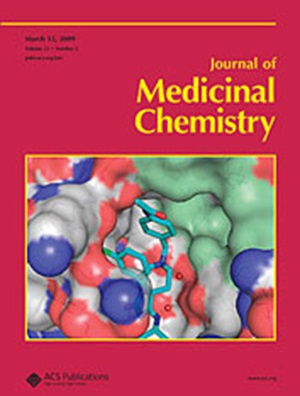5,9-和5,8-二氨基烷氧基取代二苯并蒽醌类似物酪氨酸- dna磷酸二酯酶1抑制剂的合成及其放射增敏活性
IF 6.8
1区 医学
Q1 CHEMISTRY, MEDICINAL
引用次数: 0
摘要
酪氨酸- dna磷酸二酯酶1 (TDP1)是肿瘤化疗和放疗的潜在靶点。关于TDP1抑制剂在化疗中的应用有一些报道,但在放疗中的应用尚无报道。在此,我们设计并合成了一系列有标题的类似物。12个类似物显示出较高的TDP1抑制活性。其中18 (IC50 = 6.9 μM)在结直肠癌细胞中表现出较强的放射增敏作用,在HCT116异种移植动物模型中联合x射线辐射可抑制肿瘤生长,急性毒性低,药代动力学(PK)参数良好,值得进一步临床研究。进一步研究表明,18可以靶向细胞TDP1,抑制NHEJ修复活性,导致辐射诱导的DNA损伤,导致癌细胞死亡。此外,18还可以增加PIG3的表达,导致辐射诱导的细胞ROS增强和线粒体功能障碍。我们的研究提供了一种结合TDP1抑制剂和放疗的新型癌症治疗策略。本文章由计算机程序翻译,如有差异,请以英文原文为准。

Synthesis of 5,9- and 5,8-Diaminoalkoxy Substituted Benzophenanthridinone Analogues as Tyrosyl-DNA Phosphodiesterase 1 Inhibitors and Their Radiosensitizing Activity
Tyrosyl-DNA phosphodiesterase 1 (TDP1) is a potential target for cancer chemotherapy and radiotherapy. There are a few reports on TDP1 inhibitors used in chemotherapy, but no report on their use in radiotherapy. Herein, we designed and synthesized a series of titled analogues. Twelve analogues showed high TDP1 inhibitory activity. Among them, 18 (IC50 = 6.9 μM) showed strong radiosensitization in colorectal cancer cells, and could suppress tumor growth in the HCT116 xenograft animal model combined with X-ray radiation, and exhibited low acute toxicity with good pharmacokinetic (PK) parameters, implying that 18 is worth further clinical research. Further studies indicated that 18 could target cellular TDP1 and suppress NHEJ repair activity for radiation-induced DNA damage, resulting in cancer cell death. Additionally, 18 could also increase the expression of PIG3, resulting in an enhancement of radiation-induced cellular ROS and mitochondrial dysfunction. Our studies provide a novel cancer treatment strategy combining TDP1 inhibitors and radiotherapy.
求助全文
通过发布文献求助,成功后即可免费获取论文全文。
去求助
来源期刊

Journal of Medicinal Chemistry
医学-医药化学
CiteScore
4.00
自引率
11.00%
发文量
804
审稿时长
1.9 months
期刊介绍:
The Journal of Medicinal Chemistry is a prestigious biweekly peer-reviewed publication that focuses on the multifaceted field of medicinal chemistry. Since its inception in 1959 as the Journal of Medicinal and Pharmaceutical Chemistry, it has evolved to become a cornerstone in the dissemination of research findings related to the design, synthesis, and development of therapeutic agents.
The Journal of Medicinal Chemistry is recognized for its significant impact in the scientific community, as evidenced by its 2022 impact factor of 7.3. This metric reflects the journal's influence and the importance of its content in shaping the future of drug discovery and development. The journal serves as a vital resource for chemists, pharmacologists, and other researchers interested in the molecular mechanisms of drug action and the optimization of therapeutic compounds.
 求助内容:
求助内容: 应助结果提醒方式:
应助结果提醒方式:


